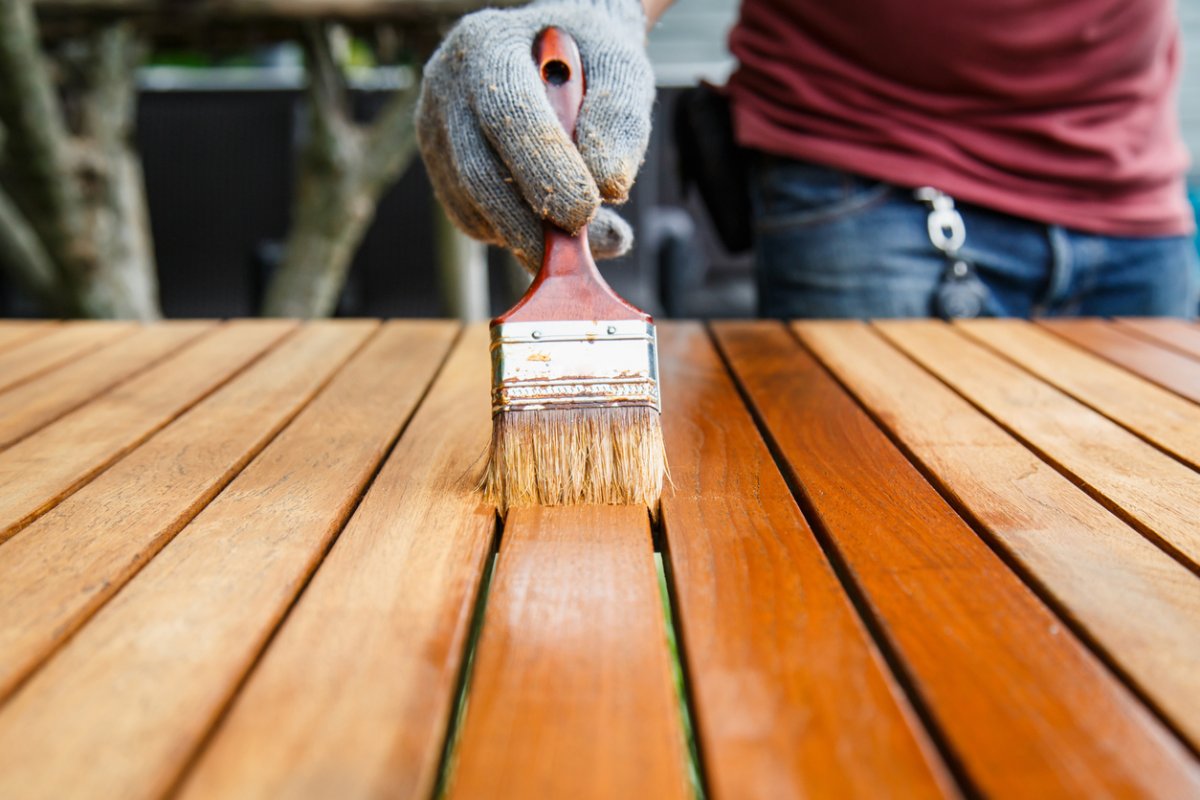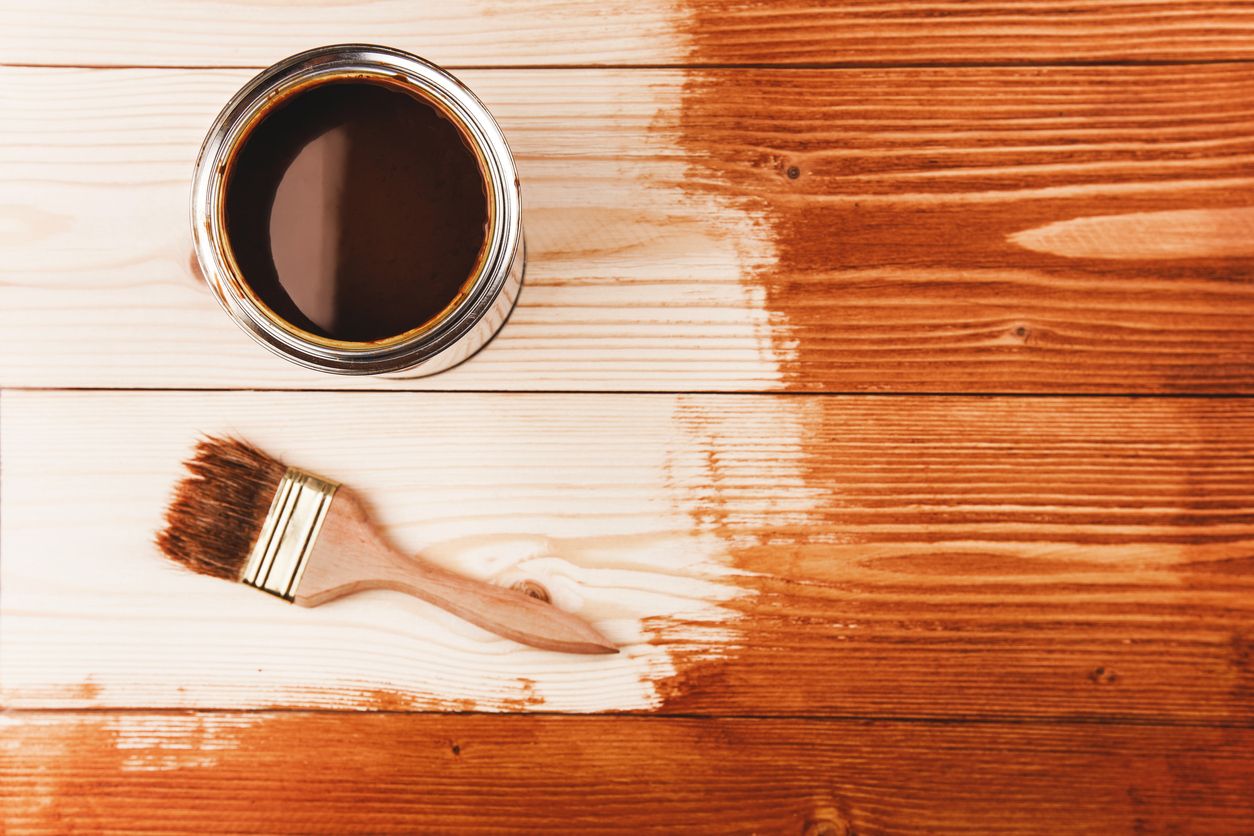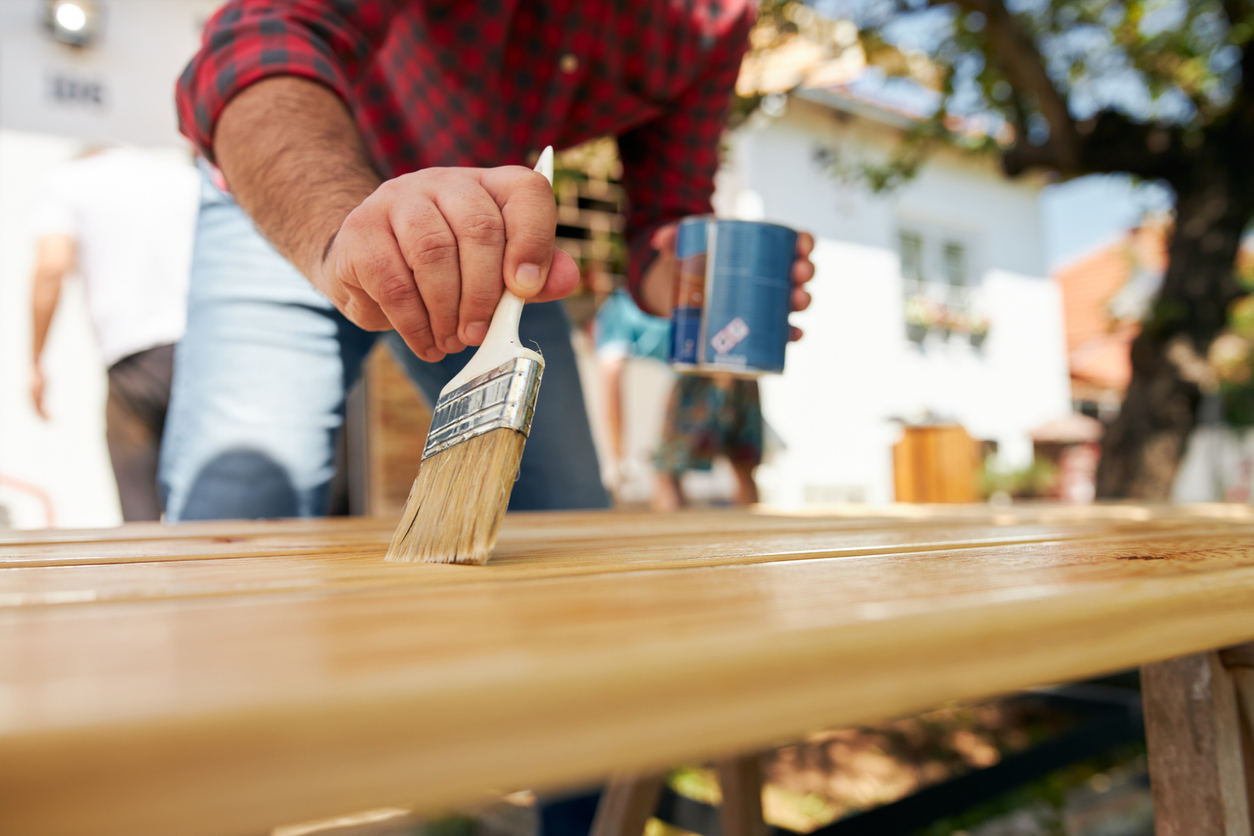

We may earn revenue from the products available on this page and participate in affiliate programs. Learn More ›
Q: I’m having a barbecue with a group of friends this weekend, and I want to show off my new deck. However, I haven’t stained it yet. How long does it generally take wood stain to dry?
A: There are several factors that can impact wood stain drying time, including the type of stain, so it’s always important to read manufacturer directions for the most reliable information. These directions can often tell you the best way to apply stain, if the product is suitable for staining over stain, and the best wood stain product for the application.
So, how long does it take wood stain to dry? The product label will provide accurate information based on the stain type. You should also consider the type of wood you are staining, amount of stain you’re applying, and weather conditions, like humidity, temperature, and air circulation. On average, wood stain takes about 24 to 72 hours to fully dry and cure, though you can typically add a second coat after about four hours.
RELATED: The Best Deck Stains for a Restored Outdoor Space
It depends on the wood you’re staining.
The type of wood used for decks, fencing, furniture, and other wooden products can include hardwood, softwood, and pressure-treated wood. Determining the type of wood can help you learn how long to let stain dry before polyurethane can be applied to the surface to seal out moisture.
Hardwood: Most staining projects go better with hardwood or pressure-treated wood. While you may need an extra coat to make sure the stain is even, hardwoods dry more quickly than softwoods, so you can expect an average drying time of about four to eight hours and a cure time of 24 to 48 hours.
Softwood: More porous than hardwoods, softwood construction materials require a longer period to dry. Depending on the type of wood stain, softwoods typically dry in about 10 to 12 hours, though they can take up to 72 hours to fully cure. This material can also cause uneven, blotchy finishes, so it’s recommended to apply a pre-stain conditioner before staining softwood.
Pressure-Treated Wood: Similar to hardwood, pressure-treated wood can be used with just about any type of stain and takes about 4 to 8 hours to dry. It can also take about 24 to 48 hours to fully cure, though this depends on the temperature, humidity, and ventilation. Apply thin coats of stain to pressure-treated wood and be ready to quickly wipe away any excess that seeps up and pools on the surface.

The type of wood stain plays a factor.
Stains, like paints, come in a variety of different types with their own situational strengths and drawbacks. Because of this, it’s necessary to learn more about the type of stain you want to use.
Water-Based Wood Stain: These wood stains use water as a solvent and incorporate a water-soluble aniline dye to add color to wood. They typically dry in just three to four hours, though they will take about 24 to 48 hours to fully cure. High humidity levels can increase the drying time for water-based wood stains more than any other type of stain.
Oil-Based Wood Stain: Many oil-based stains rely on linseed oil as a resin or binder to help the dye seep into the wood. However, oil-based wood stains take longer to dry, with many taking up to 72 hours to fully cure. Expect an average oil-based stain to dry in about 12 to 24 hours, depending on application, temperature, and ventilation.
Gel Stain: Gel stains are a relatively new type of stain that are thick and easy to apply, hiding a lot of flaws in the wood without the need to sand. Using a gel stain seems like a beneficial choice, but they take longer to dry than any other type of stain. You may need to wait a full 24 hours or more for these products to dry, while curing can take up to seven days.
Lacquer: Lacquer dries in about 15 minutes regardless of ventilation. However, powerful fumes make lacquer dangerous to use in enclosed spaces, so make sure the area is well-ventilated to avoid potential breathing risks. It’s also recommended to wear a respirator mask while working with lacquer.
Varnish: Polyurethane is often applied over stain to help protect the wood, but varnish uses polyurethane as a type of synthetic liquid resin so that the application of this solution protects your projects from heat, chemicals, and water after it dries. Varnish dries in about 15 minutes, but it has a tendency to become splotchy if the varnish is allowed to wood. To prevent this from happening, make sure to wipe off excess stain as soon as possible.
Dye Stain: Typically applied as a spray, most dye stains are made up of wood colorants and acetone. These products are essentially the opposite of gel stains in that they dry very quickly and have a very thin consistency. However, this also means that dye stains are not effective for covering up flaws in the wood. They are better for enhancing wood’s natural appearance.
Temperature, humidity, and air circulation can impact how long it takes wood stain to dry.
When you are learning how to apply stain, the temperature, humidity, and air circulation are critical factors that can increase or decrease drying time. The best temperature for staining wood typically ranges from about 50 to 90 degrees Fahrenheit. If you are working outdoors, consider starting early to make sure the stained surface can dry throughout the warm afternoon.
Humidity also impacts the drying time. Stain dries slowly in high humidity, so try to complete staining projects when the humidity is low. Similarly, it’s important to have good air circulation to help dry the stained surface. Consider the difference between trying to dry a towel in a sauna versus drying it outside.
RELATED: Paints, Stains, and More: Choosing the Right Wood Finish for Any Project

Tips for Making Wood Stain Dry Faster
There are several steps you can take to improve the drying time of your wood stain, including simply choosing a day with good weather. Consider using these tips on your next wood staining project.
Apply thin coats and wipe off excess wood stain.
Wood is a porous material, which means that it can absorb the stain that you apply, but only until the wood is full. Like a sponge, the wood can no longer absorb stain at a given point, so instead of continuing to apply and reapply copious amounts of stain, just apply thin coats of stain to the target surface. Then wipe off any stain that doesn’t absorb and settles on top.
Increase air circulation.
Many staining projects are completed outside, where air circulation isn’t a problem, but if you are staining a piece of furniture, then it may be left drying in a workshop or shed. Increasing the room’s air circulation by setting a fan or opening a window can help reduce drying time while preventing potentially harmful fume build-up.
Don’t apply stain right after pressure washing.
If you just finished pressure washing the deck and are eager to get started with the staining process, you may instead be wondering how long wood takes to dry. That’s a good question to ask, as wood needs to be dry before staining. Otherwise, the water inside the wood will prevent the stain from being properly absorbed.
Choose a warm, low-humidity day for your wood-staining project.
The porous nature of wood means that extra moisture in the air on a humid day can impede the drying process. Additionally, cold temperatures below 50 degrees Fahrenheit also increase the amount of time it takes wood stain to dry. For the fastest drying time possible, choose a warm, low-humidity day to stain wood.
RELATED: The Best Solid Deck Stains to Protect and Revitalize, Tested
